Weekly Email – Easter Day
Documents
Dear friends,
How do you explain why we believe in the Resurrection?
It’s one of the most important questions people who have no faith ask Christians. “Yes,” they say, “I can admire the teachings of Jesus, I think he was one of the most important people in history; yes, I respect the good Christians do, and the way your religion clearly helps you make sense of life, but I just can’t believe that a man can come back to life from death. It has never happened before and it’s never going to happen again, so why should I believe it happened to Jesus?”
It’s a tricky question and many theologians have come up with lots of different arguments to explain the Resurrection. For me, one of the most important arguments to make about the Resurrection is that although it may be difficult to conceive or understand, there is nothing fundamentally illogical or unreasonable about it as a proposition.
What I mean is this. If you believe God does exist, and that he is all-powerful and all-knowing, then it ought to be perfectly possible for him to do something he would not usually do. If God is all-powerful, then he is free to act as he wishes.
Normally, the laws of physics and nature mean when we die, our bodies decay, but it is perfectly possible, if he wanted to, for God to raise one particular person from death. You may consider it unlikely, or you may say that makes God capricious and unreliable, but you can’t say it is illogical or impossible. And that’s the nub at the heart of the question.
Faith is not something that switches off our brains when we think about this matter. Rather Faith is thing that allows us to imagine outside the box. It is the instinct that comes from God that allows us to wonder, what if God is all-powerful, what if he is all-loving, and forgiving, and wants to show us through the restoration to life of his Son that we can hope for eternal life.
What if his raising one person shows him not to be capricious and unreliable, but creative and full of abundant possibility beyond the certain mechanics of what science predicts is likely. What if this story of new life were true, wouldn’t that completely change the world?
We wait today in the space and time between Christ’s death and his glorious Resurrection. Once the Liturgy of the Passion is finished this afternoon, there remains to us solely the task of holy waiting. The enormity of what Christ has done for us on Calvary is so immense that we stand with the whole of creation in silent wonder, trusting that out of the pain and defeat of the Cross, new life can spring.
And it is that silent waiting, that trustful expectation, that leads us eventually to the liturgy on Saturday night. The Easter Vigil begins in brooding darkness. It is out of that gloom that a light is struck that fans into a fire which gives light and warmth. It becomes the source of light that gradually illuminates the church as the Paschal Candle, signifying Christ’s presence, is brought into the dark empty nave, and the people of God share that light as their individual candles turn into a body of light.
It is in the Easter Vigil that the Resurrection – something which we can discuss and describe as a theoretical possibility – becomes an emotional reality in our hearts, and a sacramental reality transforming our lives.
Through encountering the Risen Lord present in the assembly of the Body Of Christ, we embrace in a heartfelt and empathetic way the reality of what the Easter story means. Through seeing his death and resurrection in those who are baptized, we witness new Christians reborn in Christ. And in receiving the Eucharist, the sacrament of Easter, we are strengthened as Christ’s Body and become one with him.
I pray that as we commemorate today the death of Christ in our liturgy, and wait longingly for Christ’s Resurrection, God may fill our hearts with joy and confidence to proclaim Christ as our risen saviour and as the ultimate sign of God’s love for us and for all people.
Fr Peter
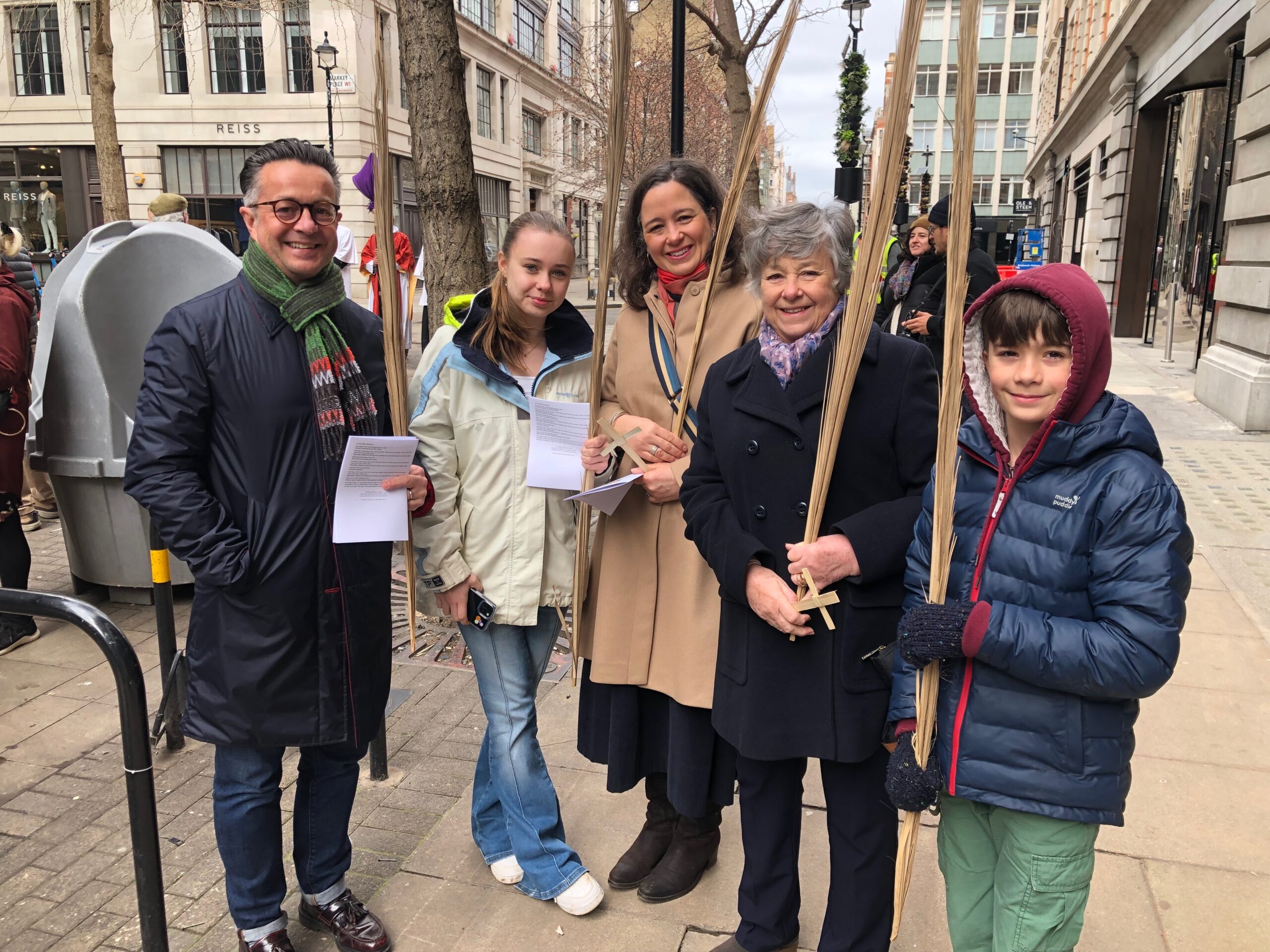
“Hosanna to the Son of David!” Parishioners and friends await our procession of palms last Sunday.
Easter Triduum
Good Friday 7th April 2023
3.00 pm Solemn Liturgy with sermon by the Bishop of Fulham
Music: Crux Fidelis & Reproaches, Palestrina; Ecce quomodo moritur justus, Handl.
Live-stream here.
7.30 pm Stations of the Cross (Maria Desolata)
Holy Saturday 8th April 2023
9.00 pm Easter Vigil with baptisms, confirmations and sermon by the Bishop of Fulham
Live-stream here.
Music: Messe Solenelle, Vierne.
Easter Day 9th April 2023
11.00 am High Mass with sermon by the Bishop of Fulham
Music: Krönungsmesse K317, Mozart; Easter Hymn, Mascagni.
Live-stream here.
5.15 pm Mass
6.00 pm Evensong, Te Deum, and Benediction
Music: Stanford in C; Blessed be the God and Father, Wesley; Te Deum, Sumsion in G.
Live-stream here.

A huge thank you to everyone who helped as stewards at our Palm Sunday procession. We are grateful to them for ensuring the procession took place safely, and with everyone feeling relaxed and secure. A particularly word of thanks should go to Chris Swift and Nick Gralka for coordination the recruitment and training of our procession stewards!
Holy Week preaching
It has been such a delight to hear Bishop Jonathan preach for us over the past few days. He has been reflecting on the mysteries of Holy Week in the light of the poetry of John Donne. He has prepared a booklet of the poems he has been quoting from which you can see as a download at the end of this email.
On Palm Sunday, Bishop Jonathan explored the many betrayals that lie at the heart of the Passion narrative in our sermon at the High Mass including Peter’s and the people of Judaea. Donne approaches a similar theme and uses language which on a first reading could feel anti-semitic in describing the rejection of Christ by the people of Jerusalem in his sonnet Divine Meditations No 7. However, he uses that troubling language to reveal how it is our betrayals of Christ that drove Christ to Calvary. Watch Palm Sunday’s homily here.
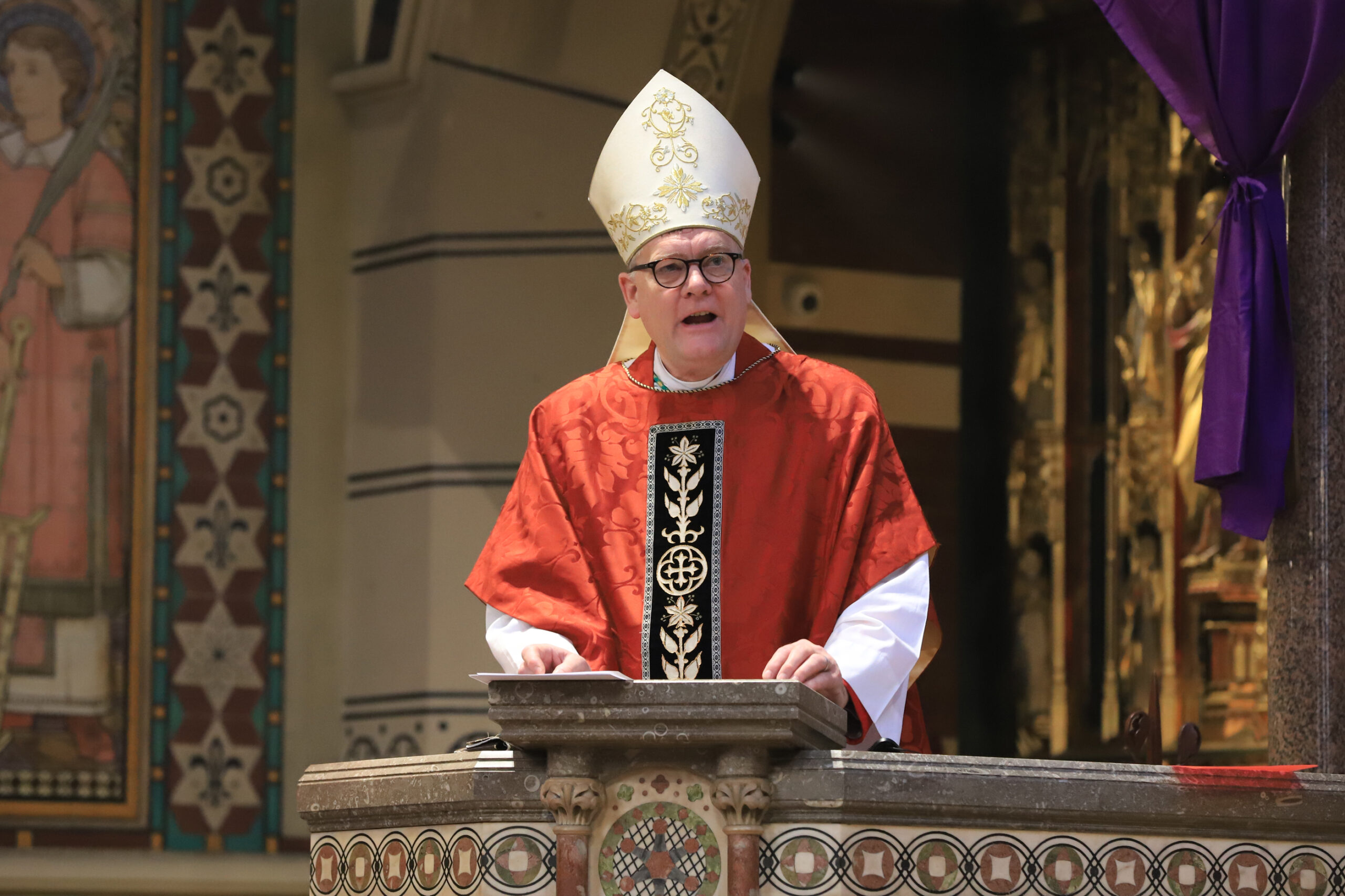
In his homily at the Low Mass for Holy Monday, Bishop Jonathan reflected on the figures in that day’s gospel. The gospel recounts the meal Jesus has at the house of Lazarus, along with Mary’s gracious act of pouring ointment on his feet, and Judas preparing for his act of betrayal. Bishop Jonathan saw elements of their roles and vocations echoed in the first three stanzas of Donne’s poem, “A litanie” – the poet yearns, like Lazarus, for new life, and speaks of the inner outpouring of love in a way that echoes Mary of Bethany’s gift of self. Watch Holy Monday’s sermon again here.
Bishop Jonathan preached on Holy Wednesday on the self-deception and self-sabotage that lie at the heart of Judas’ actions and of our own sin. John Donne explores this conflicted character of the human heart and sees Christ’s death as the remedy and source of healing which we need – for in Christ there is no self-deceit, but rather a perfect openness to his Father’s will. Watch Holy Wednesday’s homily again here.
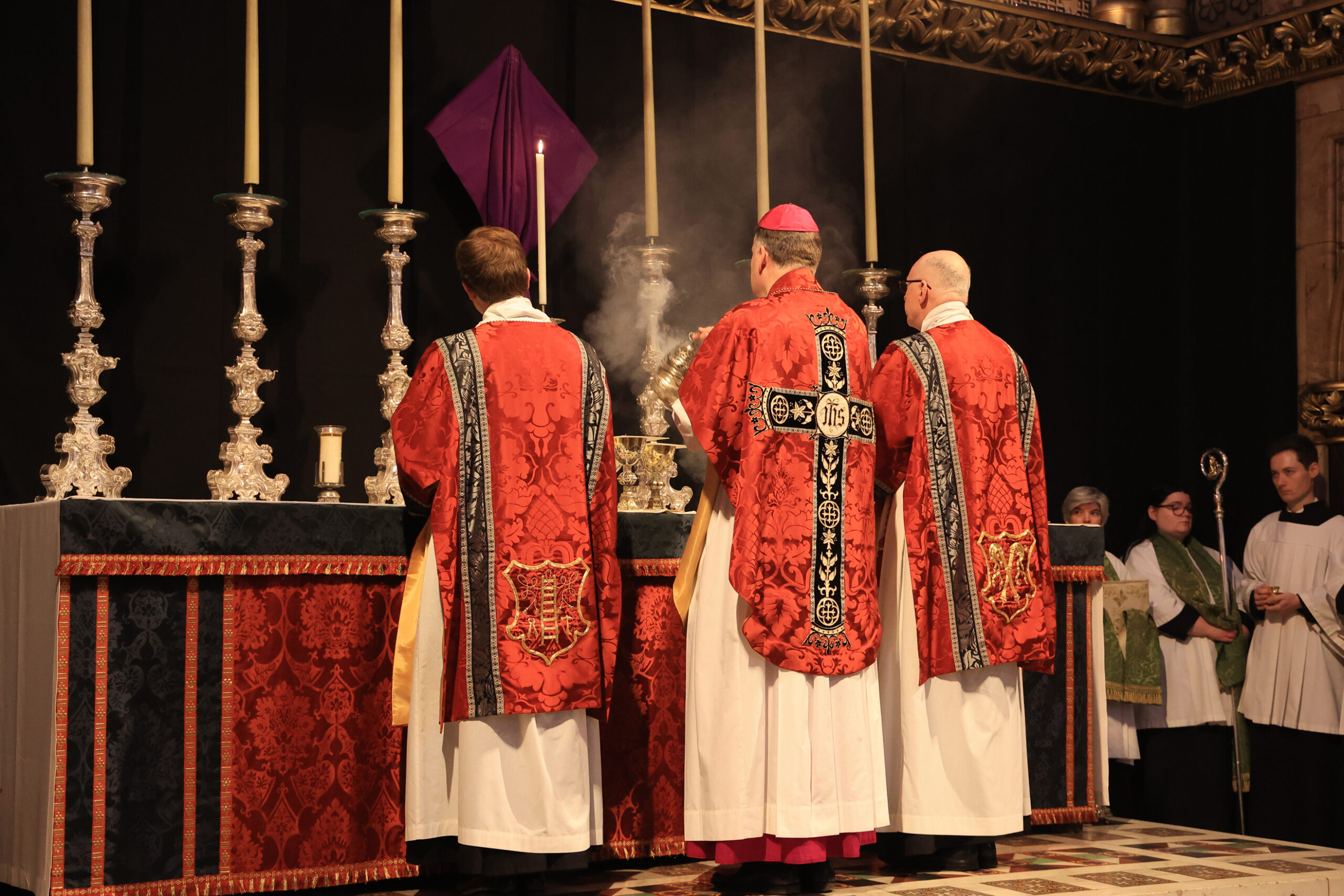
You can watch the whole liturgy for Palm Sunday morning, including the outside procession on our YouTube channel here.
Why I volunteer
We continue our series of short articles from members of our congregation about why and how they volunteer at All Saints’. This week we hear from Samantha Parker on her experience of serving at All Saints’:
Serving God and the church at the altar at All Saints every week is one of the greatest privileges of my life. I started serving at St Paul’s Cathedral in 2017, not long after I was baptized and confirmed there, and fell in love with it, coming to All Saints’ a year or so later.
It’s a real honour to be able to be part of our beautiful liturgy in such an intimate way – and that really is how I would describe it. A way to be intimate and close to God and to experience the Mass in a completely different way than when I am sitting in a pew.
All Saints’ gives so much to me that I am pleased to be able to give back in this way and to be part of a community of people working together to worship God through the liturgy each week. It takes a lot of time, patience, communication and team work to pull off some of the more complicated services (as we see in Holy Week!) but serving with this loyal and supportive group of people has given me the skills to do so!
Sam Parker
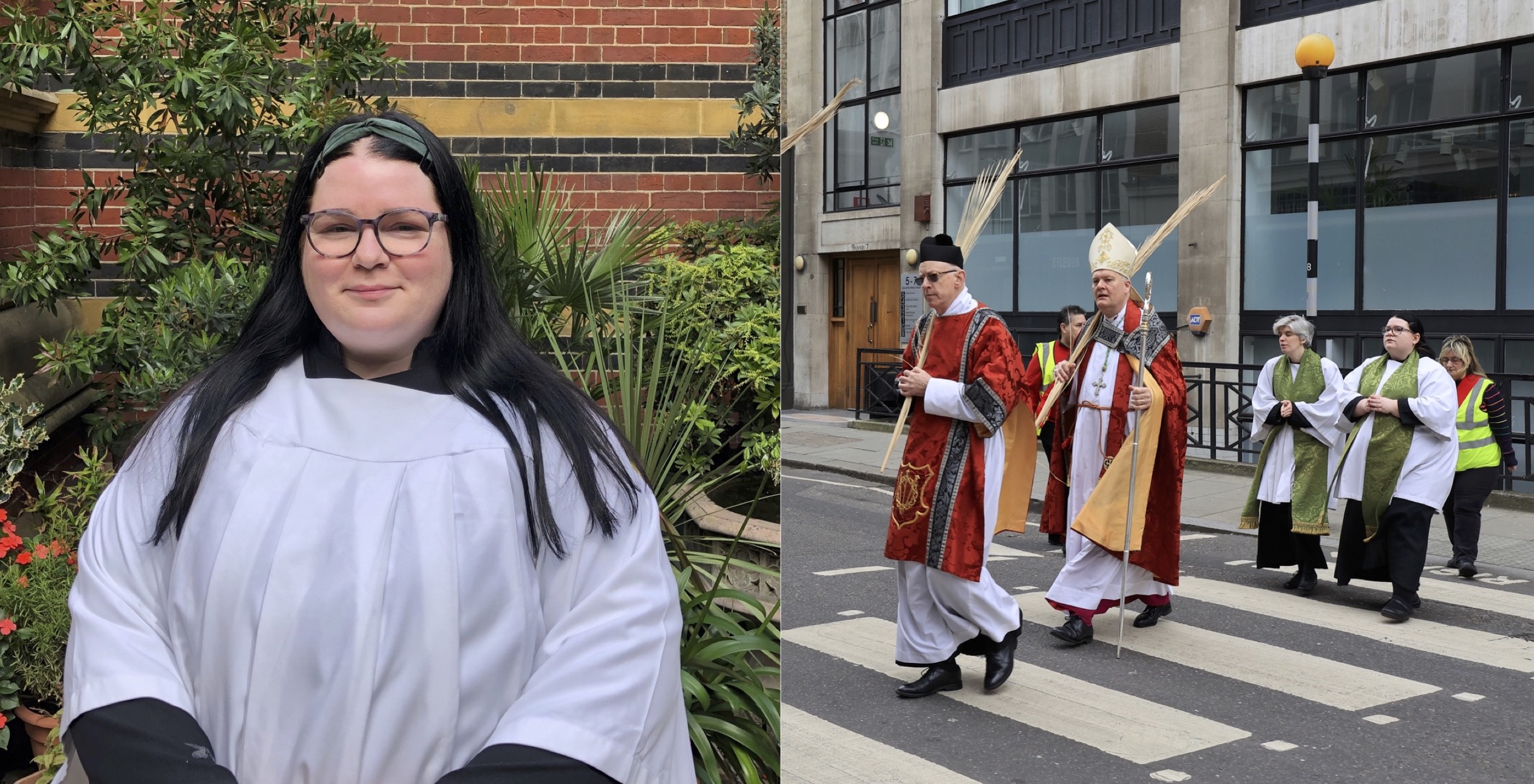
Sam Parker acts as vimpa bearer on Palm Sunday, escorting the sacred ministers over a Zebra crossing! We are so grateful to her for all she has contributed to our serving team.
Easter Flowers
If anyone would like to make a donation towards the flowers for the Altar of Repose on Maundy Thursday and Easter, please contact the office or make a donation through the website or a BACS payment, putting a reference of “flowers”. A Gift Aid donation would be much appreciated, wherever possible.

Fr Alan, Fr Peter and Shawn Welby-Cooke went early to the New Covent Garden flower market on Maundy Thursday to get blooms for our altar of repose. Fr Alan went in his “country casual” look; Fr Peter went as Fred Dibnah! Huge thanks to Shawn for all he does to organise and arrange flowers for All Saints’. The altar of repose was, as always, magnificent this year and we are very grateful indeed!
All Saints’ Lent Appeal 2023
You can still give to the All Saints’ Lent Appeal for a week or two yet. Money raised this year through the All Saints’ Lent Appeal will be divided between:
DEC Turkey-Syria Earthquake Appeal through Christian Aid
This is a Disaster Emergency Committee made up of 15 charities including Christian Aid. DEC charities and their local partners are among the first responders providing urgent help following the disastrous earthquakes. Many thousands of men, women and children have died or are injured in the aftermath of the earthquakes in Turkey and Syria. Christian Aid has been working with local partners across the region for decades and responding to the Syria crisis since 2012. Even before this devastating earthquake, there were over four million people in need of aid in Northwest Syria.
The American Church Soup Kitchen
This contributes towards the costs of the Mental Health Worker who works at the American Church on the Tottenham Court Road. The Soup Kitchen is a resource for the homeless, elderly, lonely and vulnerable in London. They provide free meals, clothing, toiletries and a sense of belonging to nearly 150 people each day and an on-site mental health drop-in centre to help address their guests’ mental health needs.
The Bishop of London’s Lent Appeal
The Diocese of London is partnering with MANNA (Mozambique Angola Anglican Association) to help the traumatised. This year’s appeal aims to raise money to train leaders in Mozambique who can provide pastoral care and support for those with trauma. Since 2017, over a million people living in northern Mozambique have been displaced by a violent insurgency and 4,000 have been killed. This is a population which is now deeply traumatised. Many professionals have said that their need for trauma counselling and support is as great as their need for food, but agencies and organisations do not have funds for this.
You can make a donation to our Lent Appeal here.
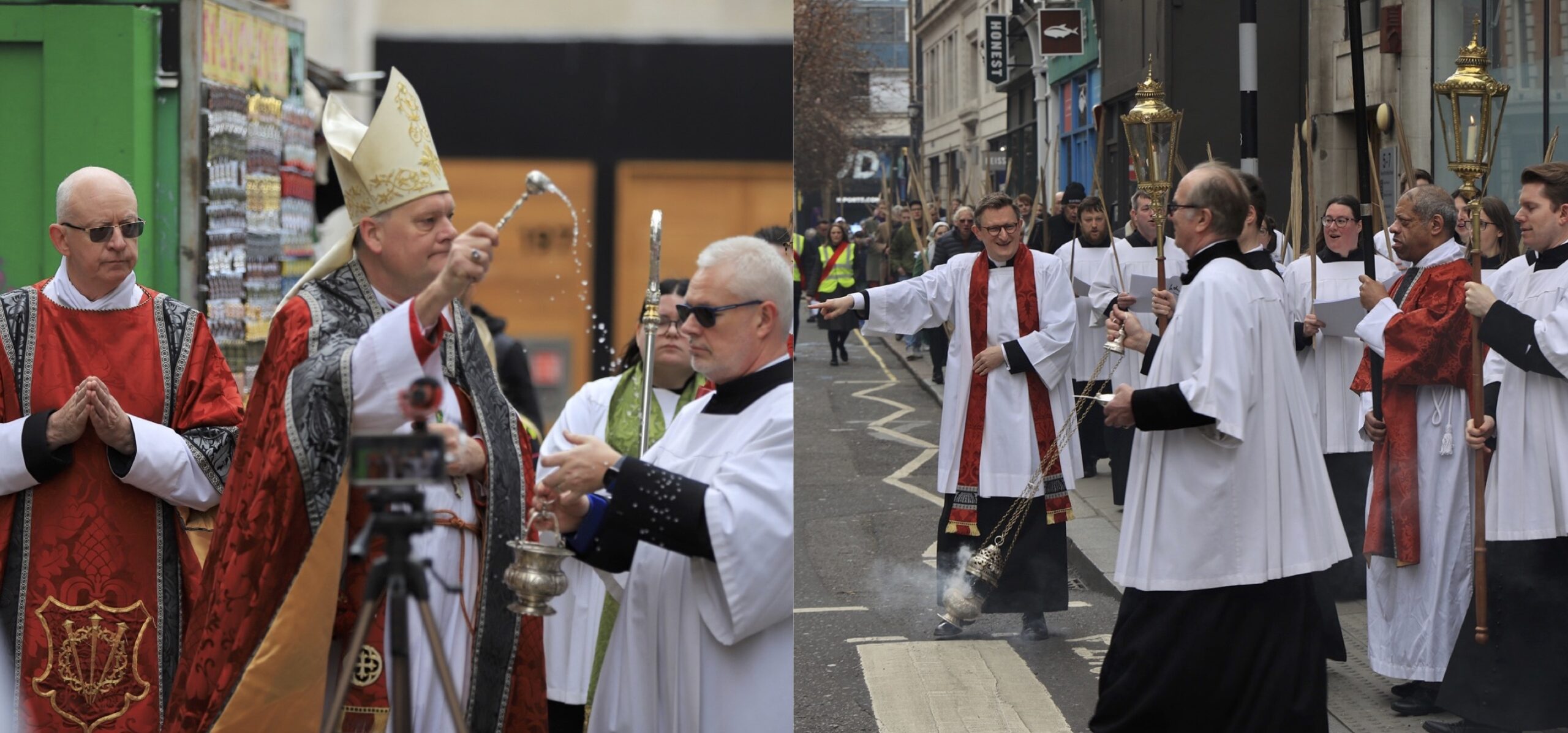
The blessing of palms in Oxford Market, followed by procession into All Saints’ Church.
Chrism Mass 2023
Several members of All Saints’ attended the Bishop of Fulham’s Chrism Mass on Holy Tuesday at St Andrew’s, Holborn.
It was a moving opportunity to thank God for our ministry together and to pledge ourselves afresh to his service for the year ahead. The holy oils were blessed for use over the next 12 months – indeed they will be put to immediate use at All Saints’ at the baptisms and confirmations at the Easter Vigil tomorrow.
Priests and deacons renewed their ordination vows, and it was good to see the Bishops of Southwark and London present at this celebration of our shared ministry in Christ.

The Bishop of Fulham concelebrates the Mass of Chrism at St Andrew’s, Holborn.
Tenebrae
You can watch our celebration of Tenebrae from Holy Wednesday here. A fascinating little article appeared in the Daily Telegraph last week by Christopher Howse about Tenebrae. You can read it with illustrations here.
If you are unable to get beyond the pay wall, the text is here:
“The service of Tenebrae was dear to the hearts of many for its memorable use of candles that were extinguished one by one as the sung liturgy went on. It was also, I think, cathartic, like a tragedy in the theatre, because the subject of the service was the death of Jesus expressed through the Lamentations for Jerusalem attributed to the prophet Jeremiah.
The poetry and the music of the occasion appealed aesthetically; for people with faith the reality of the narrative gave it a far deeper resonance.
You’d have to be fairly old to remember the Tenebrae in their heyday, for Pope Pius XII rearranged the timetable of Holy Week in 1955, so that the three Tenebrae were no longer held on the eves of the days to which they referred.
Historically they were the matins and lauds of the Divine Office for Maundy Thursday, Good Friday and Holy Saturday. Originally these hours would have been sung at midnight and at dawn. In their familiar form, they were anticipated, which is to say, celebrated the evening before the days to which they related. I think the day on which this practice held out longest was Spy Wednesday. What are billed as Tenebrae now are generally abbreviated, though I am not sure what the Mozarabic liturgy gets up to in Holy Week.
Of course, to the words and music were added the extinguishing of candles. The 15 candles were ideally mounted in a hearse or freestanding candlestick shaped like a gable. After each psalm one was extinguished, on alternate sides, starting at the bottom. The candles on the altar were extinguished during the Benedictus, which ends the ceremony (the canticle of Zachary). The last candle was either hidden behind the altar or (as in the Dominican rite) simply put out. When all was dark, the service was closed with a strepitus, a loud noise, made perhaps by a big book brought down on a wooden surface. Congregational pew-thumping would sound too much like a meeting of the 1922 Committee.
Tenebrae lasts a long time, because there are nine psalms to be sung and nine readings. Before each psalm a short antiphon is chanted; after each reading there is a sung responsory – a couple of biblical verses with a brief versicle sung in reply. Among composers to set these responsories were Tomás Luis de Victoria (1585) and Carlo Gesualdo (1611).
To me the texts from Lamentations stand out. The nine readings over three days cover all five chapters of this short, aptly named book of the Bible. In our day comfort is attempted even before a mourner has expressed grief. In Lamentations, the grief for the death of Jesus (even though the worshippers know that he has risen from the dead) is expressed in harsh figures of war and suffering. “Our skin was black like an oven because of the terrible famine,” says one verse. O vos omnes qui transitis per viam, attendite, et videte si est dolor sicut dolor meus: “All ye that pass by, behold, and see if there be any sorrow like unto my sorrow.”
It is the poetry of desolation, a counterpart to Goya’s (almost unapproachable) Horrors of War or to film footage of war today that is only too available.
“He hath set me in dark places, as they that be dead of old,” laments Jeremiah. “He hath hedged me about, that I cannot get out: he hath made my chain heavy. Also when I cry and shout, he shutteth out my prayer.”
These things speak of the feelings of Jesus in his suffering and death and of the worshipper’s anguish at sin and sorrow. It is from these that the Resurrection of Easter springs.”
Attendance last week
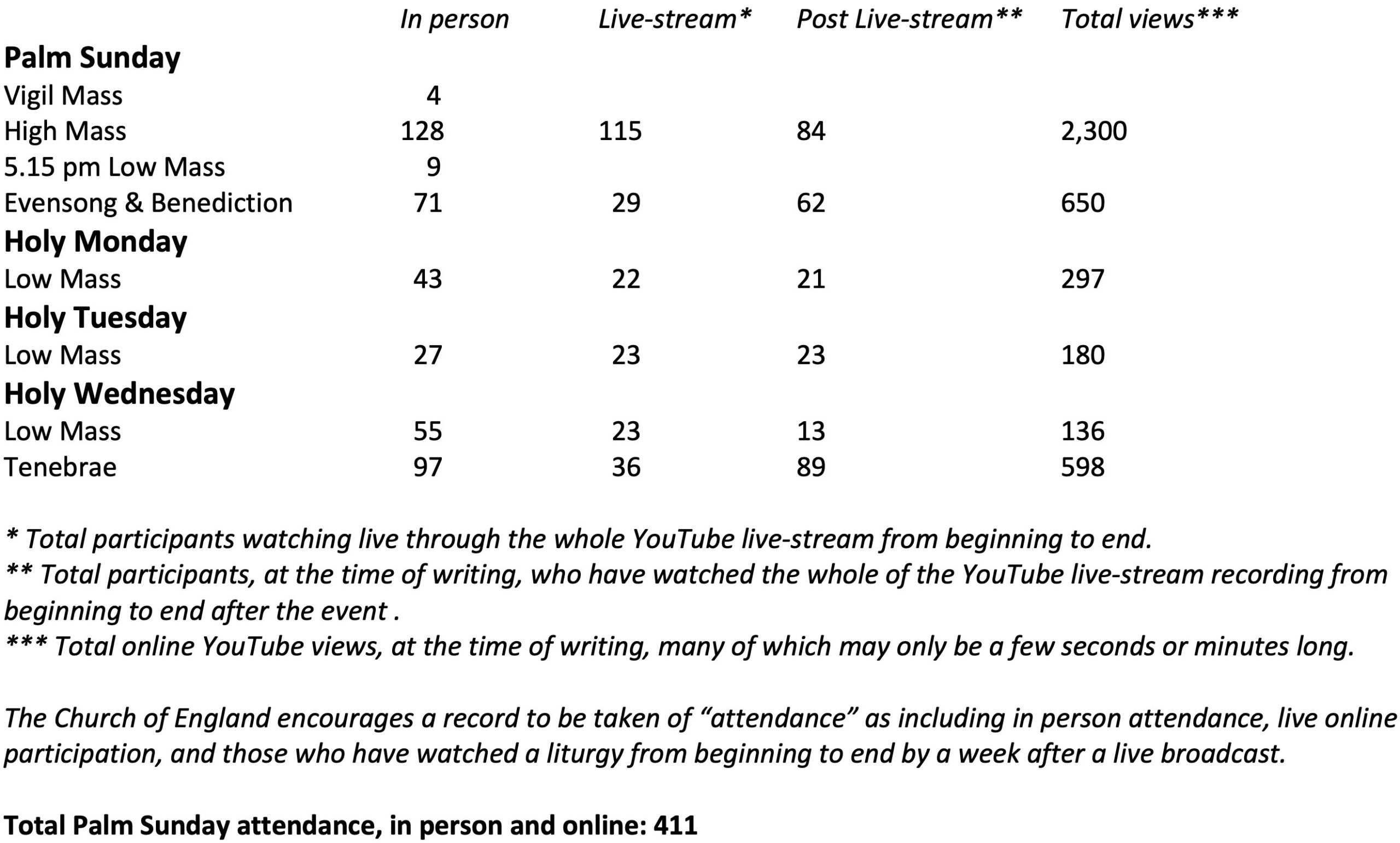
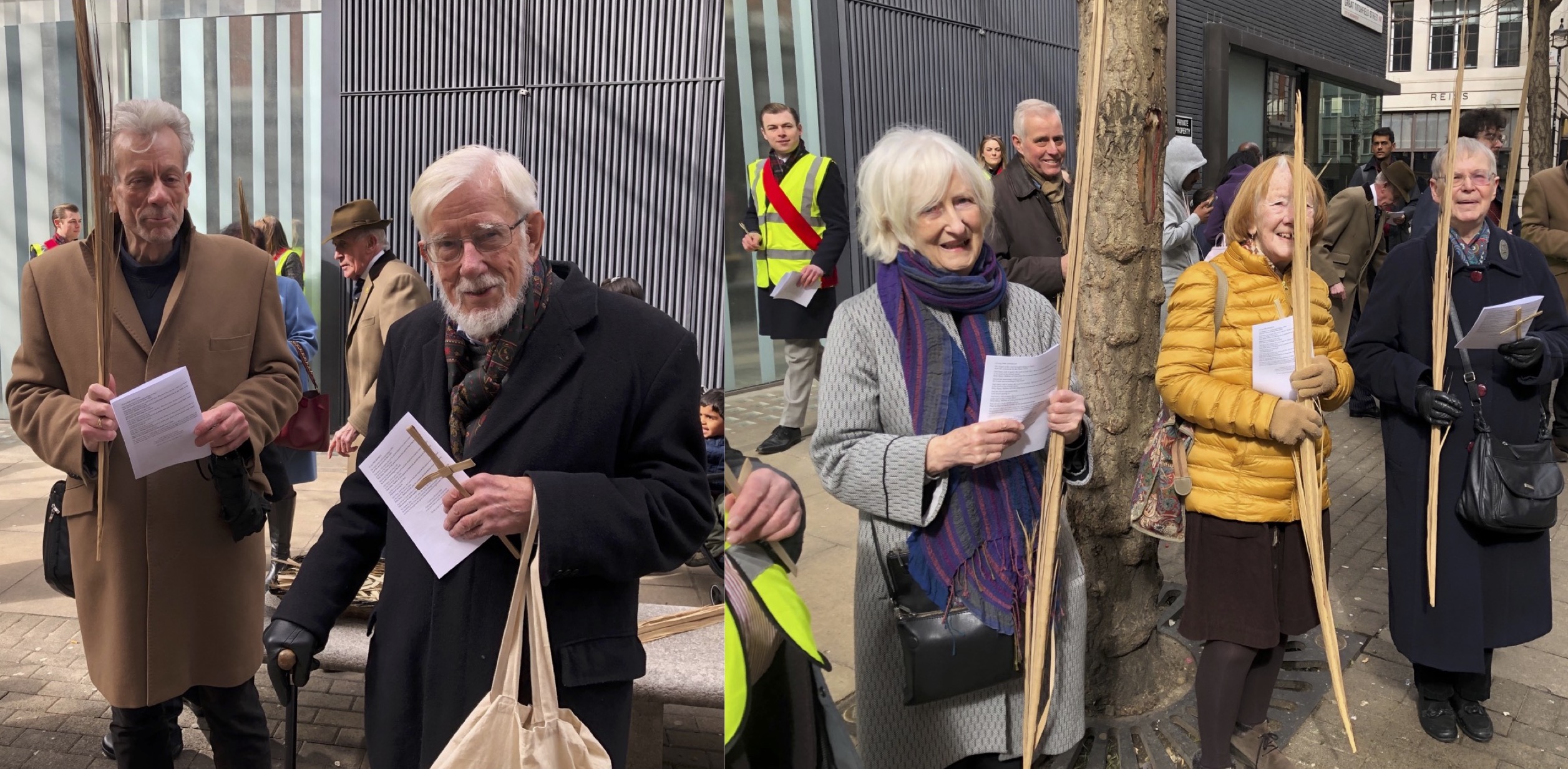
Parishioners prepare to hail Jesus as our Messiah and walk in procession with Palm branches to All Saints’ from Oxford Market last Sunday.
Links for Sunday
The links for the livestream and service sheet for this Sunday’s High Mass are at the end of this email.
Evensong and Benediction takes place at 6pm this Sunday. Music will include Stanford’s Evening Service in C, Wesley’s Blessed be the God and Father and Sumsion’s Te Deum in G. A service sheet can be found at the end of this email, and the service will be livestreamed here.
Prayer list
The sick
Fr. Harry Hodgetts, Amanda Barrett, Greg Loveday, Theresa Moses, Don McWhinney, Martin Berka, Pete Turner, James Rodger, Andrew Rodger, David Craig, Charles Thompson, Elizabeth Lyon, Ray Oram
The faithful departed
Robert Chesnutt
Anniversaries of death
April 9th – Cecil Higgins, Ada Spicer, Anne Garside, Cyril Golding-Bird Bp., Lewis Fleming
10th – Thomas Senior Pr., Brian Phillips
11th – Maud Woodin, Mildred Banyard, Roy Sutherland
12th – Edith Malcolm Wood, Norman Peryer, Eric Yates
13th – John Rogers, Dennis Burke, Justin Kelly
14th – David Evans, Stephen Woolley, Friederica Swinburne
15th – Rose Lethbridge, Christopher Dean, Julian Tan
The Friends of All Saints’
April 9th – Sue Enoch, Carolyn Farrar, Sue Feakin, Adrian Felaar, Daniel Fielden, Janice Fielden
10th – Nigel Fisher, Mark Fleming, Stuart Fletcher, Christopher Forman, Anthony Fox, Charlotte Gauthier
11th – Margaret Goddard, Paul Golding, John Goldsmith, Genevieve Gomi, The Ven. Thomas Greene, Canon Michael Gudgeon
12th – Sheelagh Gudgeon, Ginger and Del Hall, Roger Hancock, Canon Richard Handford, Jill Hargreaves, Christopher Harrison
13th – Patrick Hartley, Canon Jeremy Haselock, Eoghan Healy, Fr. David Hobden, Canon, Graham Holcombe, James and Gwendoline Holdcroft
14th – Edwin Holmes, Bp. David Hope, Richard Hoskinson, Fr. David Hutt, Andrew Jervis, Arthur Johnson, Malcolm Kemp
15th – Alan Kimbrough, Brenda Koupis, The Very Rev’d Harry Krauss, Deirdre Laing, Graham Last, Christopher Laws
Service times this week
Saturday 8th April – Holy Saturday
9.00 pm High Mass of Vigil
Sunday 9th April – Easter Day
11.00 am High Mass
5.15 pm Mass
6.00 pm Evensong, Te Deum and Benediction
Monday 10th April – in Easter Week
12.00 pm Mass
Tuesday 11th April – in Easter Week
12.00 pm Mass
6.30 pm Mass
Wednesday 12th April – in Easter Week
12.00 pm Mass
6.30 pm Mass
Thursday 13th April – in Easter Week
12.00 pm Mass
6.30 pm Mass
Friday 14th April – in Easter Week
12.00 pm Mass
6.30 pm Mass
Saturday 15th April – in Easter Week
12.00 pm Mass
6.30 pm Mass
Sunday 16th April – The Second Sunday of Easter
11.00 am High Mass
5.15 pm Mass
6.00 pm Evensong and Benediction

